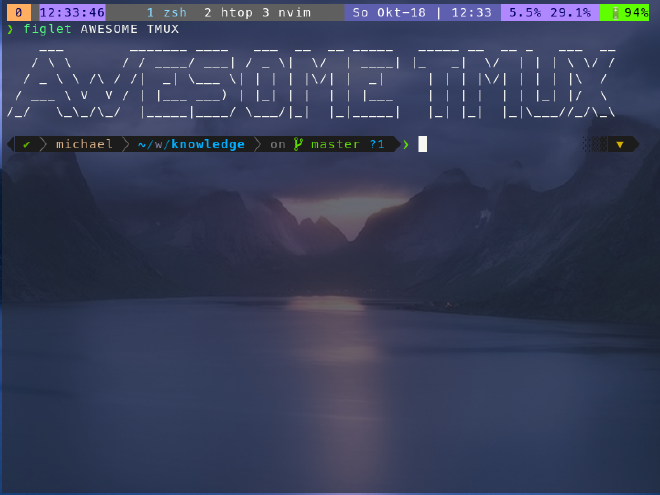Tmux

Find my tmux config here and here all of my dotfiles
Why tmux#
- Multiple shell windows and panes from a single connection
- Session functionality that survives disconnects
- Session sharing
- Plugins extend functionality
- Keyboard driven
- Highly customizable
Alternative: screen which comes preinstalled on most distributions
Basic concepts#
- Windows are like tabs in your internet browser
- Panes are splits of windows each containing an individual shell
- Sessions represent a state of different windows and panes
Starting tmux#
tmux # start fresh session
tmux new-session -s NAME # create new session with NAME
tmux a # attach to session
tmux a -t NAME # attach to named session
tmux ls # list running sessions
tmux kill-session -t NAME # kill session NAME
Commands#
Commands are composed of the tmux prefix (default CTRL+b) and the actual command. Be aware that my config may vary!
| command | action |
|---|---|
| prefix c | create new window |
| prefix n | switch to window number n |
| prefix & | kill current window |
| prefix w | list windows |
| prefix , | rename window |
| prefix . | move window to given number |
| prefix % | split window vertically |
| prefix " | split window horizontally |
| prefix x | kill current pane |
| prefix d | detach tmux (back to normal shell) |
| prefix ? | list shortcuts |
| prefix t | show big clock |
Command prompt#
With :you can start a command prompt similar to Vim’s ex mode. Tab-autocompletion is available
Advanced#
Respawn tmux pane#
In tmux command mode
:respawn-pane -k
Set tmux as login shell#
In your .bashrc or zshrc
if command -v tmux>/dev/null; then
[[ ! $TERM =~ screen ]] && [ -z $TMUX ] && exec tmux
fi
Attach to a tmux session within tmux#
list sessions
: list-sessions
Attach to session identified by its number
: attach-session -t NUMBER
There are no articles to list here yet.
